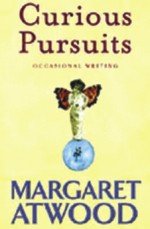|
Book
Review
Curious
Pursuits
Curious
Pursuits
Margaret Atwood
Stephanie Merritt
 By
the time she began contributing to her high-school magazine,
Margaret Atwood explains, she had already decided that she
wanted to be a writer, 'a very dedicated one, with the resulting
lung illnesses, unhappy affairs, alcoholism and early death
that would surely follow - but I knew I would have to have
a day job in order to afford the squalid flat and the absinthe'. By
the time she began contributing to her high-school magazine,
Margaret Atwood explains, she had already decided that she
wanted to be a writer, 'a very dedicated one, with the resulting
lung illnesses, unhappy affairs, alcoholism and early death
that would surely follow - but I knew I would have to have
a day job in order to afford the squalid flat and the absinthe'.
As for
so many would-be novelists, that job turned out to be hack
work, and this collection is a selection of Atwood's occasional
writings from 1970 to the present.
She divides
the book into three chronological sections bookended by historical
events; the first concludes with the fall of the Berlin Wall
in 1989, the second with the non-event of the millennium,
while the third is concerned with shifts in the world since
11 September 2001.
For women
of my generation, born midway through what Atwood calls 'the
decade of rampant feminism', this first part is striking for
its relentless and often defensive discourse on gender and
serves as a reminder of how much has changed for women in
the past three decades and how much we now take for granted.
It is
almost unthinkable now that a woman novelist would feel obliged
to defend her characters on anything other than an individual
or local level. No woman who creates an unpleasant male character
is accused of making a statement about all men on behalf of
all women, nor are we expected to produce only such women
characters as make 'good role models' for the movement.
Reading
Atwood as she returns to this debate over and over again,
we may feel rather as she claims to have felt on first reading
Virginia Woolf as a teenager: 'Lily Briscoe suffers the aggression
of an insecure man who keeps telling her that women can't
paint and women can't write, but I didn't see why she should
be so upset about it: the guy was obviously a drip, so who
cared what he thought? Anyway, no one had ever said that sort
of thing to me, not yet.'
But any
woman who writes fiction now ought to read this section as
a history lesson and feel profound gratitude that we no longer
have to spend quite so much time arguing our right to write
at all.
The most
interesting pieces gathered here are the most personal, since
they retain a freshness that feels closer to fiction and less
dated than the more journalistic commentary. 'The Grunge Look'
is a lovely, self-mocking account of visiting Europe for the
first time as an earnest graduate; early Sixties London is
summoned with the novelist's eye for an image, and her dry
humour works best in these kind of narrative pieces.
The book
reviews have endured less well. As she points out in the introduction,
newspaper reviewing and literary criticism are distinct forms
which only rarely coincide; the former, she suggests, derives
from village gossip ('loved her, hated him, and did you get
a load of the shoes?') rather than academic traditions.
Her own
reviews, at least the examples preserved here, are firmly
in the former category; added to the admission that she only
reviews books she likes, the subjective, chatty tone of these
pieces means they lack the kind of critical authority that
would make them worth preserving as essays (of Toni Morrison's
Beloved, she writes 'in three words or less, it's a hair-raiser').
Her progressive
political views have remained constant through the decades,
and her voice rings out clear and true in the final section.
In these pieces, you will not find arguments of intricate
political philosophy; rather, they are heartfelt, passionate
and personal pleas for a different way of looking at the world.
Some might say such an approach was characteristic of women;
better to say it is certainly characteristic of this writer,
who has fought proudly for the individual against such generalisations.
Source:
The Guardian
Copyright
(R) thedailystar.net 2005
| 